Cider – Get Fruity and “Savour the Flavour”
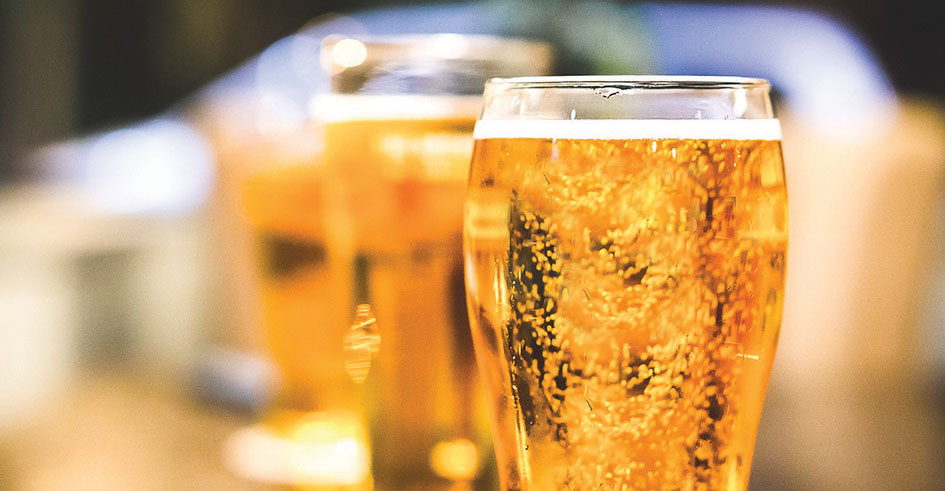
“I am Falling in love again with autumn,
The smell of warm cider,
I love autumn for so many reasons,
I must admit-
This is my favourite season”
Charmaine J Forde
It will come as no surprise that the appeal of cider is broader than ever, and in what is probably the drink sector’s fastest moving category in living memory, keeping up with trends in cider can sometimes prove to be a challenge even for the most experienced of operators.
Cider has played a major role so far this year in driving sales in pubs bars and restaurants, not only with mainstream ciders, but also with the meteoric rise of fruit ciders and the increasing popularity of premium and craft ciders.
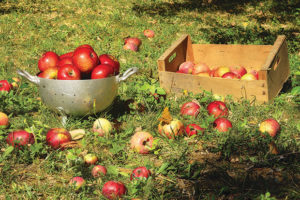 “Cider has once again made a huge contribution to the on-trade retailers overall sales and we see no sign of this changing” said Matthew Langley, insight and innovation manager at Weston’s cider. “Outperformed only by spirits and soft drinks there were the equivalent of 10 million more pints of cider sold in the on trade over the past year, £516 million in total”
“Cider has once again made a huge contribution to the on-trade retailers overall sales and we see no sign of this changing” said Matthew Langley, insight and innovation manager at Weston’s cider. “Outperformed only by spirits and soft drinks there were the equivalent of 10 million more pints of cider sold in the on trade over the past year, £516 million in total”
“Even more encouragingly, value (+4%) has continued to grow ahead of volume (+1.9%) which signals how drinkers are continuing to trade up to more premium ciders, whilst new exclusive research reveals that the breadth of cider drinkers continues to widen. All these factors are clearly good news for the category’s long-term prospects,” he added.
Good weather and key sporting fixtures help to drive cider sales, however many producers report strong sales throughout the year, indicating that cider is no longer dependent on sunshine to get the tills ringing, and is now a “gift that keeps on giving” with sales strong throughout the autumn and winter months. Although fruit and craft brands are continuing to drive the growth of cider, there is still a place for the popular mainstream heavyweights on any bar or fridge. Changing consumer trends reveal that as a nation while we may be drinking less, we are not necessarily spending less, preferring to pay more for good-quality brands that offer great taste. More than half of us enjoy a glass or two of cider, leading industry experts to predict that the category could be worth £3.6bn by 2021.
CIDER CATEGORY PERFORMANCE
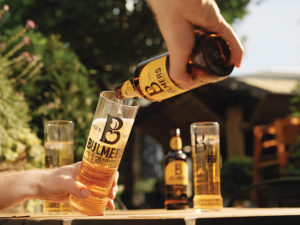 Cider has seen steady growth over the last five years – generating almost £2BN of revenue and enjoying 4% value growth annually– making it an incredibly important category for the on-trade all year round. Draught cider has experienced almost 9% annual value growth and now occupies 68% total value share, while packaged cider still holds an impressive 32% share.
Cider has seen steady growth over the last five years – generating almost £2BN of revenue and enjoying 4% value growth annually– making it an incredibly important category for the on-trade all year round. Draught cider has experienced almost 9% annual value growth and now occupies 68% total value share, while packaged cider still holds an impressive 32% share.
With over 500,000 pints poured every day, mainstream apple accounts for over two thirds of all draught cider sales and should be the first cider tap on almost every bar, said Jerry Sheddon Category and Trade Markeing director at Heineken. “Many cider drinkers remain loyal to mainstream choices, shown through the average price per pint increase of 25p in cider versus 41p in lager. As apple cider is often a single tap environment, outlets that swap a mainstream cider for a premium option are in danger of alienating existing mainstream consumers. That said, premium outlets, such as the best high street bars offering ‘a bit of style’, should make their first tap a premium apple cider to cater to consumer demand and maximise revenues.”
Although the number of occasions in the on-trade has declined, consumers are treating themselves when they do go out and choosing more premium drinks. Licensees of most outlet types (traditional community pubs, premium locals and high street bars) should offer a premium cider alongside mainstream options to encourage trade up. Premium apple cider is modern, craft-led and satisfies consumers looking to treat themselves to something special, while delivering 20p per pint additional revenue.
GETTING FRUITY
While pear cider has enjoyed a steep decline in on trade sales (-25.8% in volume) and represents only 1.4% of on-trade cider volume sales fruit sales overall show and opposite trend, and impressively so. Fruit cider in the on-trade now represents 40% of all cider volume sold and is now worth an estimated £827 billion up 14.2% in volume and 15% in value, and this is an accelerating trend where the pace of growth is increasing.
As such fruit ciders now enjoy a distinctive presence in any bar and no longer confined to back bar fridges. The growth of fruit varieties in cider are also having an influential effect encouraging people to choose a particular cider over another drink, in fact 80% of people now say a new flavour of cider influences their purchasing decision.
Furthermore, fruit cider continues to bring more consumers to the category particularly women who now make up over 60% of fruit cider drinkers compared with 47% of all cider drinkers. Fruit cider is also bringing younger consumers into the category with half of fruit cider drinkers aged 18-34 compared with 36% of all cider drinkers. Matthew of Weston Cider added “we are predicting that fruit cider will account for almost half of all cider sales by 2023 if current growth continues at the same rate”.
Flavoured cider caters to consumers’ experimental and sweeter palates, and outlets who have added a flavoured cider tap to their bar are reaping the sales benefits, says Heinekens Jerry Sheddon: “In fact, 70% of the volume delivered by adding a flavoured cider is incremental to an outlet’s cider sales – an additional £340M to the on-trade. Strongbow Dark Fruit is the fastest growing and second biggest cider in the UK, accounting for seven in every eight pints of flavoured cider consumed in the on-trade, and caters to the increasing consumer demand for fruity flavours and a sweeter taste, as half of pubs do not currently range a flavoured cider, there is a huge opportunity to do so in the marketplace.”
“Whilst varieties such as pear may be in decline, fruit cider has seen strong volume and value growth of over 10%3 throughout the last year, with millennials the main force behind this surge. Currently, millennials make up half of the fruit cider audience, with 67% of those being female.”
Emmy Webster, Senior Marketing
Manager, Showerings Cider Mill
• Low alcohol and alcohol free drinks are rising in credibility and acceptance
• Value white ciderand pear cider are declining
SEASONALITY
Traditionally, cider is seen as a refreshing summer drink and typically performs best in the summer months, and as autumn and winter approaches operators will be looking at ways to extend the selling period for cider, and good news is that cider has proved to be a consistent seller throughout the years. Cider manufacturers, long susceptible to the vagaries of British summer, have turned to innovation to drive cider sales all year round.
With all indications showing that cider will continue to grow in popularity, outlets should be ready to cater for that demand. Having said that and in common with many other drink categories there are periods when there is a natural surge in demand for example during the summer months, when weather is hot and during big sporting events. Illustrating this point perfectly the three biggest on trade draft cider occasions in 2018 with England’s football team’s quarter-final and semi-final matches in the World Cup, with spring and May bank holidays seeing the next biggest uplifts.
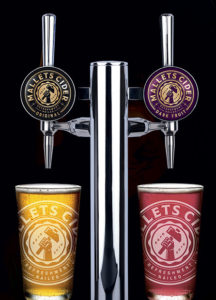 Mallets is a premium cider brand that defies the traditional, “the core consumers are millennial’s, but when you look at mainstream drinkers there is a demographic split all the way from 18 right up to 55” says senior marketing manager at Brothers Drinks Emmy Webster . Mallets delivered with standout creative and an inventive characterful journey. Available in two flavours; Mallets Original cider is a medium dry apple, created with the juice of freshly pressed apples from the company’s orchards in Somerset. Mallets Dark Fruit is a refreshing blend of Somerset apple cider with natural blackcurrant and blackberry flavours.
Mallets is a premium cider brand that defies the traditional, “the core consumers are millennial’s, but when you look at mainstream drinkers there is a demographic split all the way from 18 right up to 55” says senior marketing manager at Brothers Drinks Emmy Webster . Mallets delivered with standout creative and an inventive characterful journey. Available in two flavours; Mallets Original cider is a medium dry apple, created with the juice of freshly pressed apples from the company’s orchards in Somerset. Mallets Dark Fruit is a refreshing blend of Somerset apple cider with natural blackcurrant and blackberry flavours.
“For Mallets we were looking to get people from the younger demographic and then keep them on board so they can grow their loyalty with us. Appealing to everybody” added Emmy.
As the nights are becoming darker and in the coming weeks the temperature drops, many pubs and restaurants will be introducing warmer drinks to their menu. Mulled cider is a popular autumn drink and a great addition to any drink’s menu as a premium serve, or as part of a winter cocktail list. Not only will this tap into general premiumisation and experience trends, it will also appeal to the vast amount of cider drinkers in the market. This is great news when creating seasonal drinks for the coming months as apples are traditionally an autumn fruit and naturally pair well with winter flavours such as cinnamon, nutmeg and clove.
Martin Thatcher managing director of cider maker Thatchers says “cider is very much a year round drink but as the evenings drawing there is nothing better than enjoying a warming mulled cider in the bar. Having a branded urn on display ads theatre and customers are drawn in with the fruity and spicy aroma of mulled cider”.
HALLOWEEN FOR PUBS
 As Halloween is now the second largest occasion for pubs after New Year’s Eve, the month of October is the perfect time for operators to capitalise on the growing popularity swooping the UK, says Nicola Randall, Senior Marketing Manager, Brothers Drinks Co Ltd, “It’s even estimated that throwing a Halloween party can increase incremental spend by 30%, when compared with the average late-night customer.”
As Halloween is now the second largest occasion for pubs after New Year’s Eve, the month of October is the perfect time for operators to capitalise on the growing popularity swooping the UK, says Nicola Randall, Senior Marketing Manager, Brothers Drinks Co Ltd, “It’s even estimated that throwing a Halloween party can increase incremental spend by 30%, when compared with the average late-night customer.”
“This year, consumers are looking for new and exciting experiences, of which a niche offering, as well as premium food and drink play a huge part. Operators looking to boost their sales during this festive period should be creative and experimental in order to attract both new and existing customers, providing something different to their competitors.”
For Halloween 2019, Brothers have created a host of Halloween themed cocktail recipes to help operators capitalise on consumers’ love of toffee apple. These recipes include ‘The Poison Apple’ a heady mixture of Brothers Toffee Apple Cider and Amaretto!
Brothers Toffee Apple Cider is a Halloween favourite for those looking for a premium cider for their guests, particularly those aged 18 to 34, offering a unique taste, not available anywhere else in the market. A quality blend of cream soda and smouldering toffee, Brothers Toffee Apple is available in 500ml bottles and has an ABV of 4%.
The history of hot mulled cider bears remarkable similarities to the old pagan tradition called Wassailing. The word ‘wassail’ comes from the Anglo-Saxon phrase ‘waes hael’, which means ‘good health’. The wassail was a drink made of mulled ale, curdled cream, roasted apples, eggs, cloves, ginger, nutmeg and sugar.
CIDER AND FOOD MATCHING
Mention to a drinker that grape wine is a good match for food and they would most likely say ‘Of course it is’. However cider is also a fantastic match for food, not least says drinks educator Jane Peyton founder of School of Booze, because it contains acidity and tannins.
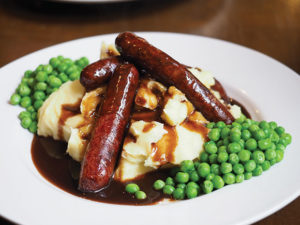 “Just as with grape wine, cider uses acidity, tannins, sweetness and texture when matching with food. Cider is often carbonated and carbonation is very useful as it clears the palate and cuts through the texture and richness of food. Cider is a versatile drink that comes in a number of iterations such as single varieties, blends, still, sparkling, tannic, acidic, dry, sweet, and ultra-sweet. It is equally at home with casual dining as it is with fine dining. Just change the glassware – cider served in glasses that are increments of imperial pints suits bar snacks and pub grub but cider in wine glasses and snifters are an elegant choice for more formal dining.”
“Just as with grape wine, cider uses acidity, tannins, sweetness and texture when matching with food. Cider is often carbonated and carbonation is very useful as it clears the palate and cuts through the texture and richness of food. Cider is a versatile drink that comes in a number of iterations such as single varieties, blends, still, sparkling, tannic, acidic, dry, sweet, and ultra-sweet. It is equally at home with casual dining as it is with fine dining. Just change the glassware – cider served in glasses that are increments of imperial pints suits bar snacks and pub grub but cider in wine glasses and snifters are an elegant choice for more formal dining.”
Most ciders in pubs are sweetened and easy drinking with low tannins, adds Jane Peyton: “They are also diluted with water to decrease the ABV to a sessionable strength. Consequently this reduces some of the power of the cider to cut through texture of food and it has to rely on high carbonation instead. What the sweetness does is act as a counterpoint to salty and savoury food, and it also acts as a foil to spicy food.”
These are some suggestions of popular pub dishes with easy drinking ciders that are likely to be found in pubs.
• Cheese Burger wand medium cider with sweetness to contrast with the savoury flavour of the food.
• Fish & Chips with a dry cider. The cider’s sharpness refreshes the palate.
• Vegetable Korma matched with a sweet cider to mellow the spiciness.
Cider is excellent with cheese especially strong cheddars, but creamy cheeses and Camembert work well too. Sweet ciders on the other hand contrast beautifully with blue cheeses while dry ciders go well with goat or sheep milk cheeses. A sweet cider also matches very well with spicy curries and Asian food and aid in cutting through the spiciness and heat.
Seafood is another cuisine that goes well with dry cider, and works as well with seafood as white wine. Oysters, oily fish and light fish compliments the dryness of cider.
Suggesting a cider match for food in a pub gives a point of difference and can help to increase sales. Wassail to that!
www.malletscider.co.uk
www.brotherscider.co.uk
TOP TIPS
1. Ensure the first cider tap on your bar is a mainstream apple cider, as it accounts for over two thirds of all draught sales and delivers strong throughputs. Only the most upmarket outlets should start their range with a premium cider, for example Strongbow Cloudy Apple and Orchard Thieves, without fear of alienating consumers.
2. Avoid removing mainstream cider in favour of premium cider – you’ll lose loyal drinkers and significant volume sales. Stock mainstream favourites, such as Strongbow Original, which accounts for two thirds of all cider poured and is quite literally worth its weight in gold.
3. Capitalise on consumer demand for fruity flavours and a sweeter taste in cider, by stocking the right range of mainstream and premium flavoured ciders, for example Strongbow Dark Fruit and Old Mout.
4. Consider offering both mainstream and premium apple and flavoured ciders on draught to appeal to a wide variety of consumer tastes and boost volume and value sales. Independent data has shown that pubs and bars stocking Strongbow Original and Strongbow Dark Fruit alongside each other will experience a rate of sale increase of a staggering 44% – the equivalent of selling an additional 62 pints a week.
5. Don’t forget packaged cider! 30% of cider sales is packaged and cider drinkers are format loyal, so it’s key to range packaged cider options to meet the needs of all your consumers. Mainstream apple accounts for over a third of packaged cider ; mainstream flavoured tends to focus on better-known berry options, while premium flavoured accounts for 60% of all packaged cider and delivers on an exotic variety of flavour choices.
